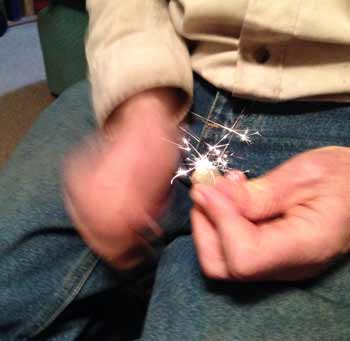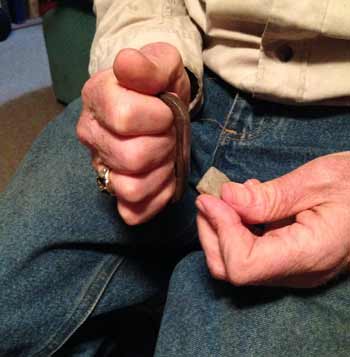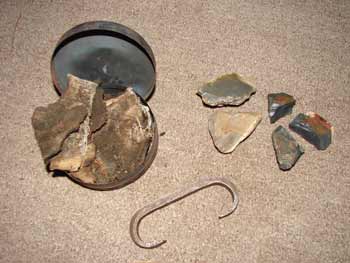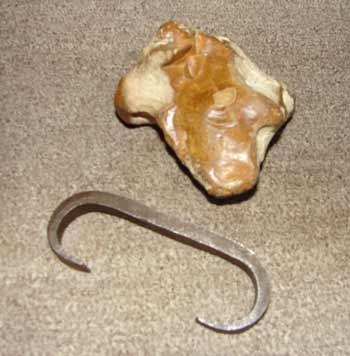Flint and Steel – Fire Starters That Never Fail
by Tom Seymour

Making sparks with flint and steel. The hand on the left holds a bar of steel which in a swift motion is pounded against a piece of flint held in the other hand. Creating these sparks near flammable material ignites the material. Forcing air over the smoldering material produces flames. Tom Seymour photo
Everyone at one time or another has need of a fire, either for warming or cooking. But how many people know how to start a fire without matches or lighters?
Also, if building an emergency warming fire during inclement weather, how many know the secrets of how to stack the fuel so that it will not fail to burn?
Most everyone in the past possessed this knowledge, but without a real need to know, these tidbits of folk wisdom have fallen into disuse. But with renewed interest in the outdoors, modern people once again can benefit from a knowledge of the old ways.
Matches deteriorate to the point of uselessness and lighters run out of fuel. But flint, steel and tinder remain viable forever. So here, let us revisit the age-old art of conjuring a fire with flint and steel.
A History
Since the Iron Age, people have employed percussion fire starting methods. The ancient Romans used flint and steel and even the famed “Ice Man Otzi” may have carried pyrite (something used prior to the introduction of high-carbon steel to strike a flint) as a fire-starting device.
Even Hollywood has used flint and steel in films. The movie The Mountain Men, starring Charlton Heston and Brian Keith, contained a brilliantly done fire-starting scene. While resting after a fatiguing adventure, Heston takes out his flint and steel and directs a shower of sparks to a small amount of tinder.
Once the tinder began to glow, Heston loosely grasped the now-smoking tinder and waved it around in a circle. At first a copious plume of smoke billows from the tinder and after perhaps the third revolution, flame breaks out. Then Heston places the now-burning tinder on a small pile of sticks and the fire begins to burn in earnest.
The entire episode was truly memorable and because of that, people have often imitated the movie scene. The first concern when attempting to employ this device is the possibility of getting a burned hand. But since the flame is originally contained within the tinder, it is possible, with care, to re-enact the movie scene without sustaining any harm.

Proper way to hold the steel and flint when preparing to strike the two together. Tom Seymour photo
The Ingredients
While the movie scene method of waving smoldering tinder around by hand seems ever so romantic, most people dispense with the hand-waving and instead place their tinder on the ground and direct sparks to it there.
But let’s back up a bit. What exactly is a steel, and how is tinder made? First, the steel is a high-carbon device that fits the hand in the manner of brass knuckles. So with a steel in one hand and a small bit of flint in the other, the user strikes the flint with the steel, doing so at a sharp angle. The sparks emitted from this action are in fact tiny, molten bits of steel, sheared off by the flint.
The first difficulty a beginner may encounter when attempting this for the first time is to use too great an angle. What we need here is just a glancing blow from the steel.
A degree of trepidation exists with many beginners, since there is a fear of missing the flint with the steel and hitting the knuckles instead. But the chances of that happening are minimal. All the same, it’s hard to not flinch when striking the flint.
Once the novice becomes adept at creating sparks, the next step is to direct the sparks to the tinder. This isn’t difficult and with a bit of practice holding the flint at the proper angle, sparks will regularly hit the tinder.
But tinder becomes an all-inclusive word, because in order to light the actual tinder, it is necessary to make char cloth. Certainly, it is possible to cause extremely dry tinder to catch a flame without need for char cloth, but it is much easier to use it.
Essentially, char cloth is a specially-prepared bit of cloth that when touched by a spark, begins smoldering. So once the char cloth begins glowing, it is immediately transferred to waiting tinder and then, by blowing on the cloth and tinder, heat increases to the point where flame erupts.

“Given intense scrutiny of what we’ve been doing and concern regarding midwater trawling…we need to address it as soon as we can,” said NEFMC member David Pierce.Tom Seymour photo
Making Char Cloth
Char cloth is an essential ingredient in flint-and-steel fire starting. To make it, find some fairly thin, all-cotton cloth. An old cotton sheet or pillowcase can supply a lifetime of char cloth.
To make the char cloth ready for use, find a safe place such as a gravel drive or other area where fire won’t spread, set the cloth on the ground and set fire to it. When only partially burned, stamp the flame out by foot. Some may wish to use a spade or other device for this purpose. Then make sure every trace of glowing cloth is extinguished.
Then, take the blackened, burnt cloth and pull it by hand into small pieces. Place these bits in a metal container. To make a realistic container for both char cloth and flint, find a metal can such as what pipe tobacco once came in (antique stores abound in old Prince Albert cans) and let it burn in a fire. This melts the finish and causes the can to develop a gray patina. Round metal boxes with tops also make good flint, steel and char cloth containers.
For those who are uncomfortable making char cloth because of the danger of fire spreading, or where any fire is prohibited by local law, cotton kerosene lamp wicks will take a spark and begin to smolder. They may not be as traditional as char cloth, but in an emergency, tradition can take a back seat in favor of practicality.
Tinder, on the other hand, can be any organic material that catches fire easily. Strands of cedar bark, rubbed between the hands to make it even finer and then stored to dry, make fine tinder. But other objects can serve as tinder as well. Crushed, dried fir needles can be added to any tinder. The downy seed heads of common cattail work pretty well too. As long as it is reduced to a fine size and is completely dry, most any highly-combustible, natural material can serve as tinder.

Nodes of yellow French flint was used as ballast and later in the flint and steel combination. Flint ballast from French ships dumped and today found along the beaches of Nova Scotia ranges from coarse yellow to fine gun flint black. 18th century flint lock rifles used a spring loaded steel hammer against a piece of flint to ignite gunpowder. Tom Seymour photo
Fire Building
Piling a bunch of dry sticks atop burning tinder may or may not result in an extended blaze. That’s because air, an important ingredient in combustion, cannot circulate through piled sticks and branches. Also, it is common to use sticks that are too large to ignite in any predictable manner. Both these errors are easily corrected.
First, it is important to get a small fire burning steadily. Then and only then is it time to add larger material.
There are several configurations used to set up sticks and twigs for a fire. Sticks set up in a teepee shape are how the majority of people build their fires. The other is the “log cabin” method. That uses small sticks and twigs set up in the manner of a log cabin. In either case, burning tinder placed at the bottom of a fire built in this manner will quickly cause the other material to combust.
For a no-fail fire, use a little more tinder than usual and have a supply of thin, dry sticks or shavings available. As the tinder burns, slowly add the sticks or shavings on top of it. After these begin burning in earnest, then and only then is it safe to add larger pieces of wood on the fire.
Handy Tips
Here are a few little items to remember when collecting wood for an emergency fire. First, standing deadwood makes the best and driest fuel. The cambium layer, or that layer immediately beneath the bark, can usually be counted upon to be dry and very flammable. And even during a rainstorm, only one side of the deadwood will be wet. The side opposite the direction the rain is coming from should remain quite dry. And despite an extended, driving rain, heartwood from standing deadwood remains dry.
When setting tinder around or beneath a dry stick teepee, do so from the “windy,” or upwind side. This enlists natural air currents in supplying oxygen to the fire and helping it catch much faster.
Both flint and steel are available commercially. But in an emergency, something other than a specially made steel will work. The bottom of a jackknife blade (keep the knife closed and use the fairly sharp edge of the bottom of the closed blade), if made out of the right steel, can coax sparks when struck by a flint. Also, an old file or even a piece of a file will work too. One writer suggests that a tine from an old hay rake does a good job.
For a commercial source of both flint and steel, just do an eBay search. Complete kits, including flint, forged striker, char cloth and tinder box run from between $12 and $24.
Hopefully, none of us will ever need to use flint and steel out of necessity. But still, having the knowledge of how to start a fire by these primitive means gives a feeling of self assurance.
And at the very least, someone skilled with flint and steel can entertain friends and family at the next camping trip.
